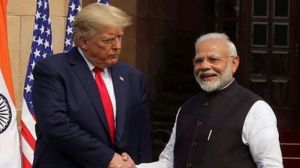Overweight model led to wrong rain forecast?
What does no rain in Delhi in July have to do with atmospheric pressure over Argentina in April? Or the amount of snow in the entire Eurasia...

What does no rain in Delhi in July have to do with atmospheric pressure over Argentina in April? Or the amount of snow in the entire Eurasian mountains last December? Or the temperature of the Pacific Ocean off Peru in March?
Quite a lot, if you ask the India Meteorological Department (IMD). For, these faraway phenomena are just three of the 16 parameters the IMD uses in its monsoon forecast model.
But this year with its forecast gone way off the mark and drought’s shadow across large parts of central and north India, experts are questioning the model and calling for its revamp.
Even Dev Raj Sikka, the man who co-invented the model, admits it has never been tested in a drought year. ‘‘Its robustness to predict extreme events is questionable,’’ says Sikka who now heads the Department of Science and Technology’s Indian Climate Research Program. For example, the model failed to predict the unusually heavy floods in 1994.
But Sikka isn’t the only one questioning the IMD’s science. J Shukla, formerly with MIT and NASA and now the head of the Center for Ocean-Land-Atmosphere Studies at George Mason University in Washington, says he’s baffled why the model has ‘‘in 13 years in a row not produced a forecast that’s very different from normal.’’
An answer to this puzzle could be the unusually high number of parameters—also called predictors—that the model is based on. Because there are so many parameters, Shukla says, the model inevitably throws up ‘‘average’’ data which leads to inaccurate prediction when the conditions are not average.
‘‘No more than three predictors should be used,’’ says Sikka. But here lies the catch: which ones? ‘‘The search for the magic predictors has already gone on for more than 100 years and predictors that are most immediate and from the preceding period’’ should be the ones to be tried out.
So how come the model has turned out pretty accurate all these years? Shukla tries to find an answer for this in his forthcoming paper to be published by the American Meteorological Society’s Journal of Climate. ‘‘A fact which may help to explain the apparent recent success of this model is that the period 1989-2000 happens to be a rare period in which predictions based on the climatology of the prior 25 years are unusually good.
This reflects the fact that the monsoon rainfall has been near normal every year during this period. Consequently, any forecast model that predicts near normal rainfall during this period will have a relatively small mean square error.’’
In other words, the last 13 years have been normal monsoon years and so the IMD got it right.
Says Shukla: ‘IMD has never published objective, quantitative and rigorous verification of its medium-range (7-10 day) forecasts. I know for sure that IMD uses one of the most outdated models for weather prediction, and therefore it is highly unlikely that medium range forecasts by IMD have significant skill.’’
Who should be held accountable for the inaccurate predictions this year. At the IMD, no one has an answer. Says Secretary, Department of Science and Technology, V S Ramamurthy: ‘‘The expectation is far more than the state-of-the-art…and if anyone could do better than IMD, I am willing to prostrate in front of him.’’
Defending the IMD’s forecast is Deputy Director General S R Kalsi: ‘‘You cannot order the environment to behave itself…this year the monsoon faced a circulation jolt, creating an anxiety among people. Dry spells are a normal part of the rich diversity in the behaviour of the monsoon.’’ Perhaps, Kalsi is waiting for a normal monsoon the next year.





- 01
- 02
- 03
- 04
- 05


![Kadapa, [Andhra Pradesh], 27 May (ANI): Andhra Pradesh Chief Minister N Chandrababu Naidu and state Minister Nara Lokesh in conversation during the Telugu Desam Party's (TDP) annual three-day Mahanadu conclave, in Kadapa on Tuesday. (ANI Photo)](https://images.indianexpress.com/2025/05/tdp.jpg?w=400)





![Kadapa, [Andhra Pradesh], 27 May (ANI): Andhra Pradesh Chief Minister N Chandrababu Naidu and state Minister Nara Lokesh in conversation during the Telugu Desam Party's (TDP) annual three-day Mahanadu conclave, in Kadapa on Tuesday. (ANI Photo)](https://images.indianexpress.com/2025/05/tdp.jpg?w=300)

















